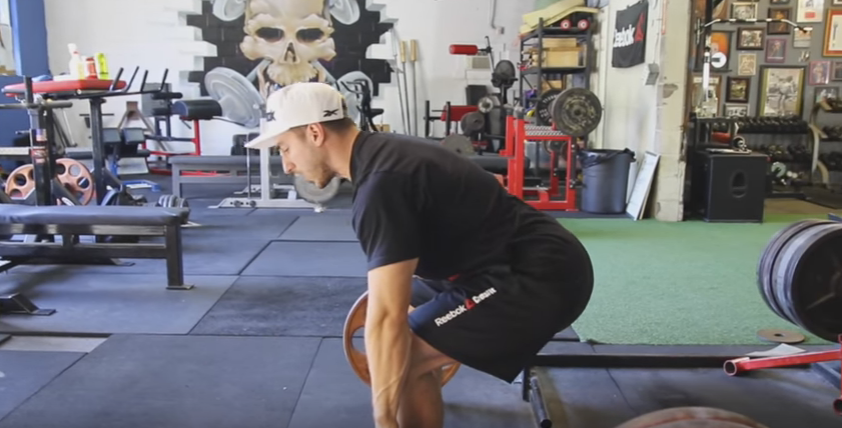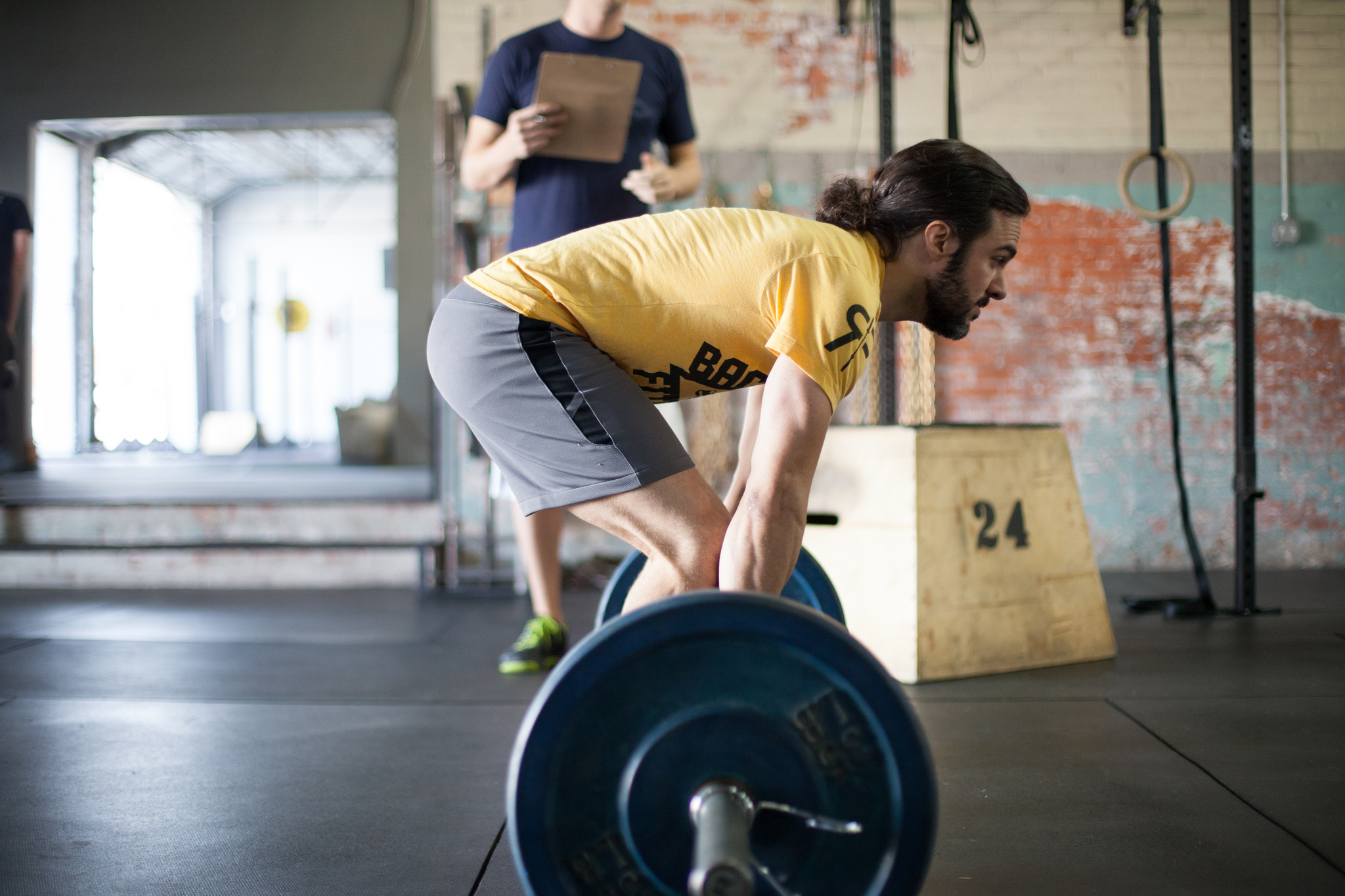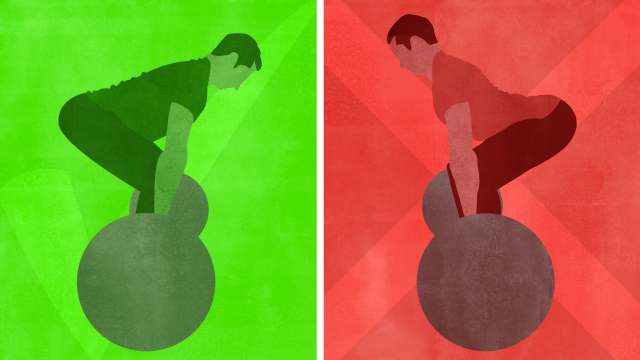You may wonder how complicated it can be to bend over and pick something heavy up, but do it wrong and your back will tell you, forcefully, that it’s very complicated. The deadlift is an incredible and practical full-body exercise, but so many things, from the way you grip the weight to how you “stand up”, have the potential to go awry.
Illustration by Sam Woolley. Images by Omar Isuf and adrian valenzuela.
You’re Not Bending Your Hips Enough

The first thing to note is that squatting down to pick up the bar and then standing back up is a good way to show your body that you hate it. The primary motion in a deadlift should essentially be “back and forth“. As we explained in our deadlift primer, this maximal hip bend but minimal knee bend motion is called a hip hinge.
Doing the hip hinge looks like you’re pushing your booty back but bending at your hips instead of simply arching your back, as if you’re trying to bump someone behind you. With a neutral spine, where you keep your entire back and neck aligned, you then thrust your pelvis forward to get back up and complete the deadlift. The hip hinge is the essence of the exercise, one where many people mess up.
Your Starting Position Sucks
A good deadlift actually begins before you even pick up the weight. Novice deadlifters typically tend to lean too far forward over the bar, placing a lot of stress on the lower back when they actually pick up the weight. The video above, by ATHLEAN-X, goes over how to set up for a proper deadlift. A lot of your setup, like your stance, the width of your feet, how close you are to the bar and so on, will depend on your body structure and a bit of personal preference.
Before you pick up the weight, take a deep belly breath and hold it to force air and tightness into your abs. Squeeze your lats (a major muscle in keeping your back straight and stable) as if you’re squeezing juice with your armpits, relieve some tension from the bar and be ready to pull as hard you can by driving your weight into your heels. All of this, of course, needs to happen rather fluidly and quickly. It will come with practise.
You Round Your Back Too Much

Maybe the weight is too heavy, you didn’t physically prepare enough to support the weight by keeping a neutral spine and tightening up your abs or your back or hip muscles are too weak. There are a number of reasons you round your back when you pick up heavy things.
If you haven’t been deadlifting for very long, it’s normal to find it difficult to keep your back neutral. You probably just aren’t used to maintaining this initially awkward position. Don’t worry, you’ll get better with more practise and as your body gets stronger. But if you have trouble reaching the bar on the floor without rounding your back, raise the height of the bar by placing it atop two or three stacked weights or the pins in the squat rack; and work on partial deadlifts to practise that neutral spine position.
Your Grip Is Too Wide
When you grasp the barbell with too wide of a grip, you won’t be able to properly engage your lat muscles, which is an integral part of the deadlift. It probably feels a bit awkward, too.
Eric Cressey, a performance coach at Cressey Performance in Boston, suggests moving your hands as close as you can to your hips. From here, you should still be able to reach down and grab the rings on the barbell and find the best width for you. Plus, with a closer grip, you can keep the barbell closer to your body for better control during your lift.
Your Arms Are Doing Too Much ‘Work’
Your arms’ primary role in a deadlift is to hold the bar steady and keep it close to your body throughout your lift. From start to finish, your arms should remain straight and fully extended. Your arms should never assist by pulling or yanking the barbell up. Keep your elbows locked and close to your body.
This video by Omar Isuf explains in great detail why it’s crucial to keep those arms straight. He explains that extended arms help keep your lats in the action. (Starting to see the pattern here?)
The Bar Drifts Away From You
In a good deadlift, imagine that the bar travels up and down a straight vertical path. If it deviates from this path, it usually means you started leaning too far forward, you didn’t contract your lats enough or the bar was too far from your starting stance to begin with. Other than keeping those lats tight, try adjusting the distance of your shins from the bar when you start. If your shins are right up against the bar, try moving it back a few centimetres. If you’re too far, then move a bit closer.
You Hyperextend Your Back at the Top of the Lift
When you drive forward with your hips to reach the top of the deadlift, called the “lockout”, many people arch their lower back at the top, jutting their pelvis out a bit when they shouldn’t. To fully lock out a deadlift, your hips and knees need to be “locked” into position. Using your back instead of your glutes shifts your knees forward and prevents your hips and knees from locking out. Instead, think about “tucking in your tail” and squeezing your butt really hard as the bar passes your knees. To reinforce this idea, check out the video above by Diesel Strength & Conditioning.
You Don’t Commit to the Pull
This is more mental than anything and something I learned first-hand recently. The other day I wasn’t confident that I could pull 113kg, but I tried anyway. I failed spectacularly to even budge the weight on my first attempt. Luckily, a friend of mine who had been watching told me I needed to commit. “Just get down and pull as hard as you can,” he told me. When I did just that, the weight came (well, staggered) up.
Of course, I was elated by my new personal best, but it also made me fully appreciate the truism of “committing to the pull”. Even if the weight is daunting as hell, you have to feel strongly about ripping that weight off the ground. There’s no “testing the weight”. You either pick it up or you don’t. Any hint of hesitation can ruin your setup and mess you up mentally.

Comments